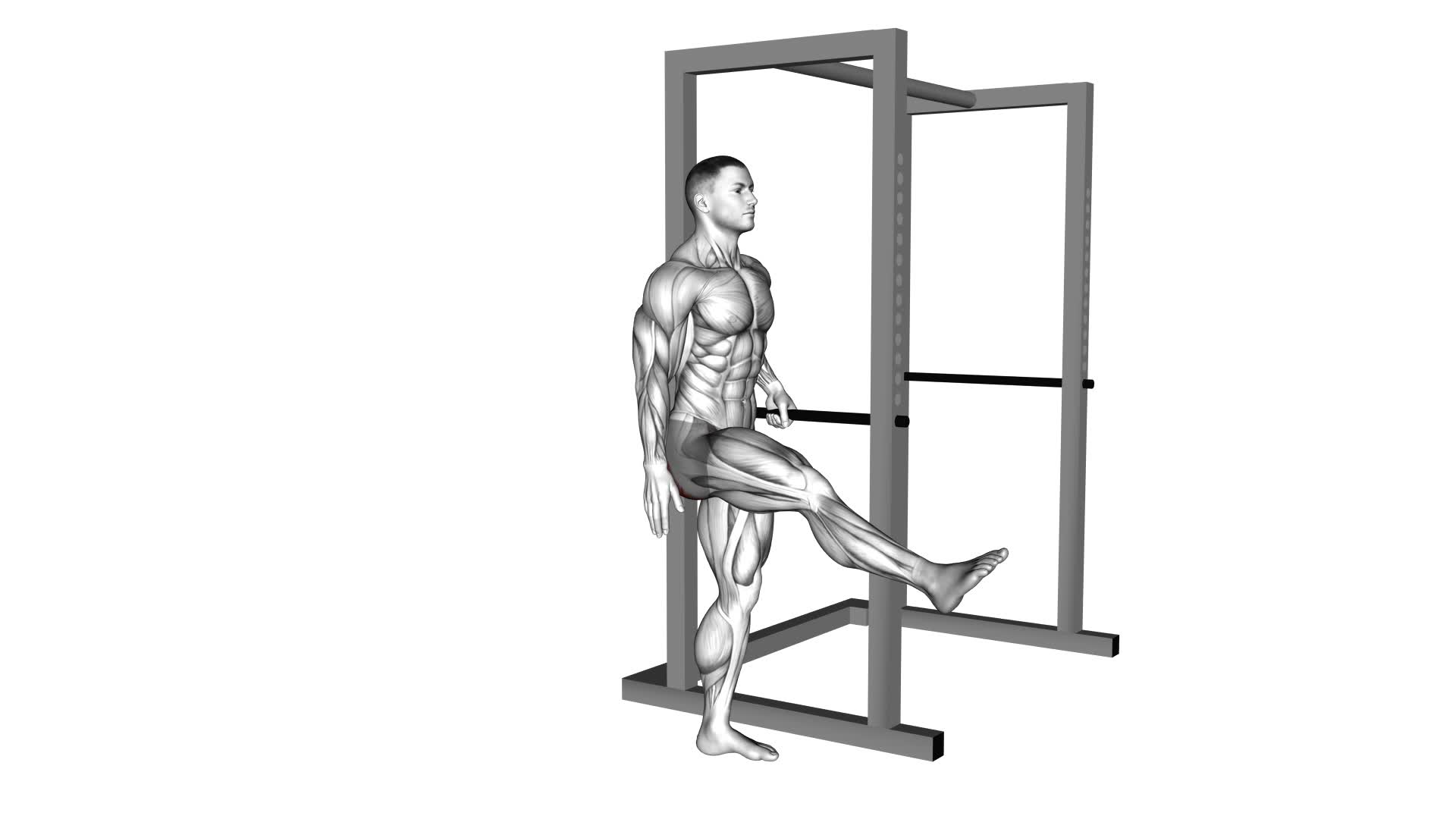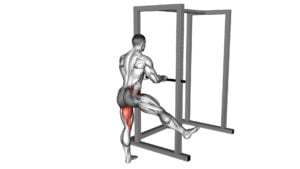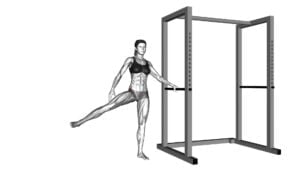Back Forward Leg Swings (male) – Video Exercise Guide & Tips

Looking to improve your lower body flexibility and strength? Check out this video exercise guide for back forward leg swings.
Watch This Exercise Video
In just a few minutes a day, you can reap the benefits of this dynamic exercise that targets your hamstrings, glutes, and hip flexors. With proper form and technique, you'll enhance your athletic performance and reduce the risk of injury.
So grab a mat, hit play, and get ready to take your leg swings to the next level!
Key Takeaways
- Back forward leg swings improve flexibility in the hips.
- Back forward leg swings strengthen the hamstrings, glutes, and hip flexors.
- Back forward leg swings enhance athletic performance and reduce the risk of injury.
- Back forward leg swings increase range of motion in the hips.
Benefits of Back Forward Leg Swings
You can experience a range of benefits from incorporating back forward leg swings into your workout routine. These exercises are great for improving flexibility and strengthening your hip muscles. By swinging your leg forward and backward with control, you can increase the range of motion in your hips and improve your overall flexibility. This is particularly beneficial for athletes, dancers, and anyone looking to enhance their performance in activities that require a wide range of motion.
In addition to improving flexibility, back forward leg swings also help to strengthen the muscles in your hips. The swinging motion engages your hip flexors, glutes, and hamstrings, which are all key muscles for stability and mobility. By regularly incorporating these exercises into your routine, you can develop stronger hip muscles, which can help prevent injuries and improve your overall strength and balance.
To get the most out of back forward leg swings, start with a slow and controlled movement. Focus on maintaining proper form and engaging the muscles in your hips. Gradually increase the range of motion as you become more comfortable and flexible. Remember to breathe and listen to your body, stopping if you feel any pain or discomfort.
Proper Form and Technique
Maintaining proper form and technique is essential when performing back forward leg swings to maximize their effectiveness and prevent injury. Here are some tips to help you perform this exercise correctly:
- Stand tall with your feet hip-width apart and engage your core muscles.
- Keep your upper body straight and gaze forward.
- Swing your leg forward, leading with your heel, while keeping it straight and parallel to the ground.
- Avoid arching your back or leaning your torso forward as you swing your leg.
- As you swing your leg back, keep it straight and extend it behind you.
- Make sure to maintain control and avoid swinging your leg too forcefully.
- Repeat the movement on one leg for the desired number of repetitions before switching to the other leg.
By following these guidelines, you'll target several muscle groups, including:
- Hamstrings: The swinging motion activates and strengthens the muscles at the back of your thighs.
- Hip flexors: The leg swings engage your hip flexor muscles, which are responsible for lifting your leg forward.
- Glutes: The backward leg swing targets your gluteal muscles, helping to tone and strengthen your buttocks.
Common mistakes to avoid include using momentum to swing your leg, rounding your back, or overextending your leg. Remember to maintain control and focus on proper form to get the most out of your back forward leg swings.
Precautions and Modifications
To ensure a safe and effective workout, it's important to consider precautions and modifications when performing back forward leg swings.
Before starting this exercise, it's crucial to warm up your muscles and joints to prevent injury. Additionally, if you have any pre-existing conditions or injuries, such as lower back pain or hip issues, it's advisable to consult with a healthcare professional before attempting this exercise.
During the back forward leg swings, it's essential to maintain proper form and technique. Keep your core engaged and your back straight throughout the movement to protect your spine. It's also important to start with a comfortable range of motion and gradually increase it as you become more comfortable and flexible. If you experience any pain or discomfort during the exercise, stop immediately and reassess your form or modify the movement.
Modifications can be made to accommodate different fitness levels and abilities. If you find the exercise too challenging, you can decrease the range of motion or perform the swings with a slower tempo. Additionally, you can use a chair or wall for support if needed. Listen to your body and adjust the exercise as necessary to ensure a safe and effective workout.
In the next section, we'll explore variations that can be incorporated to increase the intensity of back forward leg swings.
Variations to Increase Intensity
To increase the intensity of your back forward leg swings, try incorporating variations that challenge different muscles and increase the range of motion. Here are some advanced progressions and resistance band variations that you can try:
- Advanced progressions
- Single-leg back forward leg swings: Perform the exercise with one leg at a time, focusing on maintaining balance and stability throughout the movement. This variation increases the demand on your core and hip muscles.
- Weighted back forward leg swings: Hold a dumbbell or kettlebell in one hand while performing the exercise. This added resistance increases the workload on your leg and hip muscles, making it more challenging.
- Resistance band variations
- Banded back forward leg swings: Attach a resistance band around your ankle and anchor the other end to a sturdy object. As you swing your leg forward and backward, the resistance from the band adds extra tension to your leg muscles, making the exercise more challenging.
- Banded single-leg back forward leg swings: Perform the exercise with one leg while using a resistance band. This variation not only increases the resistance but also helps improve stability and balance.
Incorporating these variations into your back forward leg swings routine will help you progress and continue challenging your muscles. Remember to start with proper form and gradually increase the difficulty level to avoid injury.
Tips for Incorporating Back Forward Leg Swings Into Your Routine
To effectively incorporate back forward leg swings into your routine, it's important that you focus on proper form and gradually increase the difficulty level. One common mistake to avoid is swinging your leg too forcefully, as this can lead to strain or injury. Instead, aim for controlled and fluid movements.
Another mistake to watch out for is arching your back excessively during the swing. To maintain proper form, engage your core muscles and keep your back straight throughout the exercise.
To progress and challenge yourself with back forward leg swings, there are a few options you can try. First, you can increase the range of motion by swinging your leg higher or farther each time. This will engage your muscles more and provide a greater challenge.
Additionally, you can add ankle weights or resistance bands to intensify the exercise. These extra weights will increase the resistance and make your muscles work harder.
Remember to listen to your body and start with a level of difficulty that's appropriate for your fitness level. As you become more comfortable and stronger, gradually increase the difficulty to continue challenging yourself and seeing progress in your leg swings.
Frequently Asked Questions
How Many Sets and Reps Should I Do When Performing Back Forward Leg Swings?
When performing back forward leg swings, it's important to consider the number of sets and reps.
The ideal number of sets and reps for this exercise can vary depending on your fitness level and goals. It's recommended to start with 2-3 sets of 10-12 reps on each leg.
As you progress, you can increase the number of sets and reps or try different variations of back forward leg swings to challenge your muscles and continue to see improvements.
Can Back Forward Leg Swings Help Improve Flexibility in the Hips and Groin?
Back forward leg swings can definitely help improve flexibility in your hips and groin. By performing this exercise, you're actively stretching and engaging these muscle groups.
To properly perform back forward leg swings, stand straight with your hands on a wall for support. Swing one leg forward and backward in a controlled motion.
You can also try variations of this exercise, such as increasing the height of your leg swing or adding ankle weights, for increased difficulty.
Are There Any Specific Benefits of Back Forward Leg Swings for Athletes or Sports Performance?
Backward leg swings have specific benefits for athletes and sports performance. They help to improve flexibility and mobility in the hips and groin, which are crucial for athletic movements like running, jumping, and changing direction.
By increasing range of motion and loosening up these areas, athletes can enhance their performance and reduce the risk of injuries.
Incorporating back forward leg swings into your training routine can contribute to better overall athletic performance.
Can Back Forward Leg Swings Be Done as a Warm-Up Exercise Before a Workout?
Back forward leg swings can be a beneficial warm-up exercise before your workout. They help increase hip mobility and flexibility, which can improve your overall performance and reduce the risk of injury.
To perform them correctly, stand tall with your arms extended for balance. Swing one leg forward and backward in a smooth and controlled motion. Remember to engage your core for stability.
Incorporating back forward leg swings in your warm-up routine can enhance your workout and prepare your body for exercise.
Are There Any Common Mistakes to Avoid When Performing Back Forward Leg Swings?
When doing back forward leg swings, it's important to be aware of common mistakes to avoid.
One mistake is swinging your leg too forcefully, which can strain your muscles.
Another mistake isn't maintaining proper form and technique, such as keeping your core engaged and your back straight.
Conclusion
Incorporating back forward leg swings into your exercise routine can provide numerous benefits, such as improved flexibility, balance, and leg strength.
By following proper form and technique, you can ensure maximum effectiveness and reduce the risk of injury. Remember to listen to your body and make any necessary modifications or variations to suit your fitness level.
With these tips in mind, you can confidently add back forward leg swings to your workouts and achieve optimal results.

Author
Years ago, the spark of my life’s passion ignited in my mind the moment I stepped into the local gym for the first time. The inaugural bead of perspiration, the initial endeavor, the very first surge of endorphins, and a sense of pride that washed over me post-workout marked the beginning of my deep-seated interest in strength sports, fitness, and sports nutrition. This very curiosity blossomed rapidly into a profound fascination, propelling me to earn a Master’s degree in Physical Education from the Academy of Physical Education in Krakow, followed by a Sports Manager diploma from the Jagiellonian University. My journey of growth led me to gain more specialized qualifications, such as being a certified personal trainer with a focus on sports dietetics, a lifeguard, and an instructor for wellness and corrective gymnastics. Theoretical knowledge paired seamlessly with practical experience, reinforcing my belief that the transformation of individuals under my guidance was also a reflection of my personal growth. This belief holds true even today. Each day, I strive to push the boundaries and explore new realms. These realms gently elevate me to greater heights. The unique combination of passion for my field and the continuous quest for growth fuels my drive to break new ground.







